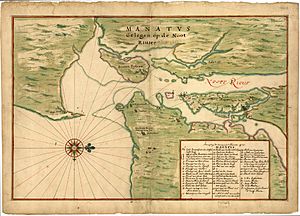Maryn Adriansen facts for kids
Maryn Adriansen (born 1600 – died around 1654) was an early settler in New Netherland, which is what New York and parts of New Jersey were called long ago. He came from Europe as an indentured servant, meaning he worked for someone for a set time to pay for his trip. Later, he became an important person in the community. He had some disagreements with the governor, but he was found innocent of any wrongdoing. Maryn Adriansen owned land in New Amsterdam (now New York City) and a big farm in a place called Awiehaken, which is now Weehawken, New Jersey.
Contents
Early Life and Background
Maryn Adriansen was born in 1600 in Veere, a town in Zeeland, Holland. From 1621 to 1627, he worked as a boatswain (a ship's officer) for Captain Claes Gerritssen Compaen. Around 1628, he married Lysbet Thyssen. It's thought he might have been in New Amsterdam as early as 1630, where his son was born. Maryn Adriansen passed away sometime before March 1654. After his death, his wife Lysbet Thysen remarried Geerlief Michelsen.
Life in Rensselaerwyck
On January 12, 1631, Adriansen made an agreement with Kiliaen van Rensselaer. He agreed to work as a tobacco farmer for three years. This type of agreement was called an Indenture. He, his wife Lysbet Thysen, their child, and some farm workers sailed from Texel on a ship called De Eendracht.
They arrived at Fort Orange shortly after July 7, 1631. Fort Orange was part of a large estate called Rensselaerwyck. This area is now near Albany, New York, in the Capital District, New York. His contract included tools like guns, axes, and spades. In 1632, he was named a schepen, which was a type of local official or judge. He likely left Rensselaerwyck in 1634 when his three-year contract ended.
Adventures in New Amsterdam
After leaving Rensselaerwyck, Adriaensen became involved in trade along the North River (Hudson River) (now known as the Hudson River). He settled near what is today Pearl Street and Wall Street in New Amsterdam. He also bought a house in an area called Smit's Vly, which was along the East River near where Maiden Lane is now.
In 1641, he was chosen to be part of an advisory group for Willem Kieft, who was the Director of New Netherland. This group was called the Twelve Men. In 1643, Adriaensen attended a dinner meeting where they discussed the situation with the Native American people. During this meeting, a plan was proposed to attack the Native Americans. Adriaensen and others signed this document, and Kieft agreed to the plan.
Sadly, this led to a terrible event where many Native Americans were killed. Kieft then ordered Adriaensen and other volunteers to attack more Native Americans who had gathered at a place called Corlaers Hook. This event also resulted in many deaths. These attacks led to a period of conflict known as Kieft's War, where the colonists suffered greatly from Native American retaliation.
Adriaensen later felt that Governor Kieft was trying to blame him for these events. He confronted Kieft, but the situation was quickly brought under control. Adriaensen was arrested and put in jail. However, his supporters pressured Kieft, and Adriaensen was sent to Holland for a trial. He was found innocent and later returned to New Netherland.
Land in Weehawken
Maryn Adriansen acquired land on the west side of the Hudson River. A map from around 1639 shows his land, which was called the "plantation of Maerynes." This area is now known as Weehawken, New Jersey.
On May 11, 1647, Director Kieft officially granted Maryn Adriansen fifty morgens of land. A morgen is an old Dutch unit of land measurement. This land was on the west side of the North River and was known as "Awiehaken."
Years later, on April 18, 1670, the government of the Province of New Jersey confirmed this land grant to Maryn Adriaensen, even though he had passed away. The land was described as "Wiehacken in the jurisdiction of Bergen on Hobooken Creek, 50 morgen Dutch measure."


